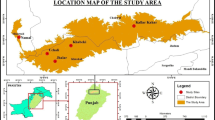Abstract
To explore geographical differences in quantitative characteristics and spatial pattern of human settlements environmental suitability (HSES) in the Three Gorges Reservoir Area (TGRA), terrain, climate, hydrology, vegetation and other natural factors were selected to build the livable environmental evaluation, and the quantitative analysis was conducted through Remote Sensing(RS) and Geographic Informational System (GIS) to reveal geographical characteristics and spatial patterns of HSES. The results are obtained as follows: (1) inhabitants of the TGRA of Chongqing are concentrated in the area with moderate high HSES, which is 78% of the total population distributed in 48% of the study area; (2) the HSES is closely related to the terrain, and it forms an arc-banded spatial succession pattern: relatively low in the northeast and the southeast while comparatively high in the west and the south; (3) large numbers of people are distributed in the area with low suitability (with higher population density than the average of the western China), but economic development level in these areas is quite low. Moreover, these areas are ecological sensitive and fragile, many kinds of eco-environmental problems have been caused by human activities. Therefore, population migration and layout are reasonable options for the development of these areas.
Similar content being viewed by others
References
Campbell A, Converse P E, Rodgers W L, 1976. The Quality of American Life: Perceptions, Evaluations, and Satisfactions. New York: Russell Sage Foundation.
Choguill C L, 1996. Toward sustainability of human settlements. Habitat International, 20(3): 5–8.
Doxiadis C A, 1968. Ekistics: An Introduction to the Science of Human Settlements. Athens Publishing Center.
Emmanuel R, 2005. Thermal comfort implications of urbanization in a warm-humid city: The Colombo metropolitan region (CMR), Sri Lanka. Building and Environment, 40(12): 1591–1601.
Feng Dingyuan, Qiu Xinfa, 1990. Calculation and analysis of the apparent temperature in the four seasons over China. Journal of Institute of Meteorology, 13(1): 71–79. (in Chinese)
Feng Zhiming, Tang Yan, Yang Yanzhao et al., 2007. The relief degree of land surface in China and its correlation with population distribution. Acta Geographica Sinica, 62(10): 1069–1082. (in Chinese)
Feng Zhiming, Tang Yan, Yang Yanzhao et al., 2008. Establishment and application of human settlements environment index model (HEI) based on GIS. Acta Geographica Sinica, 63(12): 1327–1336. (in Chinese)
Gilbert A, 1998. An urbanizing world: Global report on human settlements. Habitat International, 22(1): 75–77.
John E O, 1973. Climate and Man’s Environment: An Introduction to Applied Climatology. John Wiley & Son’s Inc., 195–206.
Li Huasheng, Xu Ruixiang, Gao Zhonggui et al., 2005. Quality evaluation of human settlements in a city scale: A case study on Nanjing city. Human Geography, 20(1): 1–5. (in Chinese)
Li Wangming, Ye Xinyue, Sun Yu, 1999. The assessment of urban human settlements: A case study of Hangzhou. Economic Geography, 19(2): 38–43. (in Chinese)
Li Xueming, Jiang Bin, Yang Bo, 2002. Study on sustainable development of human settlement: In the case of Dalian. China Populaion, Resources and Environment, 12(6): 129–131. (in Chinese)
Li Xueming, Liu Jinghua, 2003. Preliminary research on the fuzzy comprehensive appraisal to environmental climate of the urban human settlements. Economic Geography, 23(Suppl.): 656–660. (in Chinese)
Li Yuechen, Liu Chunxia, Yuan Xingzhong, 2009. Spatiotemporal features of soil and water loss in Three Gorges Reservoir Area of Chongqing. Journal of Geographical Sciences, 19: 81–94.
Liu Ping, Wang Rusong, Tang Hongshou, 2001. Approach of the method of ecological design on the environment of urban human settlement. Acta Ecologica Sinica, 21(6): 998–1002. (in Chinese)
Lv Weilin, 1997. The apparent temperature and its calculation method. Beijing Meteorology, (4): 23–25. (in Chinese)
Ning Yuemin, Zha Zhiqiang, 1999. A study of evaluation and optimization for human settlement in the metropolitan areas: Take Shanghai for example. City Planning Review, 23(6): 15–20. (in Chinese)
Spagnolo J, Dear R D, 2003. A field study of thermal comfort in outdoor and semi-outdoor environments in subtropical Sydney Australia. Building and Environment, 38(5): 721–738.
Tang Guo’an, Liu Xuejun, Fang Liang et al., 2006. The scales and scale effects of DEM and digital terrain analysis. Geomatics and Information Science of Wuhan University, 31(12): 1059–1066. (in Chinese)
Tang Yan, Feng Zhiming, Yang Yanzhao, 2008. Evaluation of climate suitability for human settlements in China. Resources Science, 30(5): 648–653. (in Chinese)
Terjung W H, 1966. Physiologic climates of the contentious United States: A bioclimatic classification based on man. Annal A.A.G., 5(1): 141–179.
Thom E C, 1959. The discomfort index. Weatherwise, 12: 57–60.
Wang Jinliang, Wang Ping, Jiang Lianfang, 2002. Study on climate comfort degree of human settlements in Kunming. Economic Geography, 22(suppl.): 196–200. (in Chinese)
Wang Yuanfei, Shen Yu, 1998. The temperature-humidity effect and human comfort in Shanghai summer. Journal of East China Normal University (Natural Science), (3): 60–66. (in Chinese)
Wu Liangyong, 2001. Introduction to Human Settlements Environment Science. Beijing: China Architecture & Building Press. (in Chinese)
Xiong Ying, Zeng Guangming, Dong Lisan et al., 2007. Quantitative evaluation of the uncertainties in the coordinated development of urban human settlement environment and economy: Taking Changsha city as an example. Acta Geographica Sinica, 62(4): 397–406. (in Chinese)
Zhang Q, Zhu C, Liu C L et al., 2005. Environmental change and its impacts on human settlement in the Yangtze Delta, P.R. China. Catena, 60(3): 267–277.
Zhang Wenzhong, Liu Wang, Meng Bin, 2005. On location advantage value of residential environment in the urban and suburban areas of Beijing. Acta Geographica Sinica, 60(1): 115–121. (in Chinese)
Author information
Authors and Affiliations
Corresponding author
Additional information
Foundation: National Natural Science Foundation of China, No.40801077; Key Scientific Research Projects of the Ministry of Education, No.209100; Natural Science Foundation of Chongqing, No.CSTC, 2008BB7367; Science & Technology Research Project Supported by Chongqing Municipal Education Commission, No.KJ070811
Author: Li Yuechen (1974–), Ph.D and Professor, specialized in the study of resource and environmental remote sensing and GIS.
Rights and permissions
About this article
Cite this article
Li, Y., Liu, C., Zhang, H. et al. Evaluation on the human settlements environment suitability in the Three Gorges Reservoir Area of Chongqing based on RS and GIS. J. Geogr. Sci. 21, 346–358 (2011). https://doi.org/10.1007/s11442-011-0849-2
Received:
Accepted:
Published:
Issue Date:
DOI: https://doi.org/10.1007/s11442-011-0849-2




